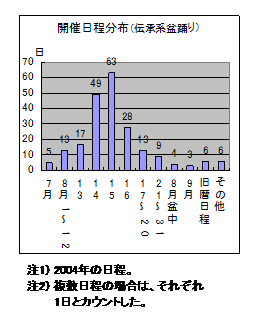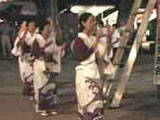The Framework of Bon Dancing
How is the structure of the specific schedule, the number of days of the festival, and the period of the festival ?
There is a common image that Bon Dancing is held one or two days at the longest, but in some regions, they dance for nearly 2 months. It is interesting to see the differences of the Bon Dancing culture depending on the region. The things that people called on to Bon Dancing emerge through the act of exploring the determining factor of the schedule and the period of Bon Dancing.
The peak of the schedule is from August 13 to 16
The period of Bon Dancing is becoming more multifaceted in the new Bon Dancings after the WW 2, although in whole, it is extremely focused in the period during August 13 to 16, and this is the peak of the schedule of Bon Dancing.
We can also confirm this fact from the results of the schedule research of the main traditional Bon Dancings which we picked up. (see the figure in the billow)

We can know from the records of “The holiday of the village” left in the diaries of the village headman in the Edo era, that around July 13 (or 14) to 16 in the lunar calendar was set as the Bon holidays, already in the early days of Edo era. *
Why is the schedule of Bon Dancing concentrated in certain periods ?
We soon notice that the schedule of August 13 to 16 corresponds exactly to the schedule of “Mukae bon to Okuri bon”. In other words, the period which is believed that “the spirits of the ancestors and the spirits of Niibon come back to hometown” is chosen as the period of Bon Dancing. Also from this fact, we can clearly perceive the meaning of “dancing in Obon” Figure: The figure of the frequency distribution of the schedule of Bon Dancing (Carried out in August, 2004)
* There are regions that Bon is not set as “holidays”. There is a theory (by Akira Abe) saying that “There was no need to set a certain date for Bon and The New Year because everybody acknowledges them as religious services. (Reference work: “Kurashi no nakano minzokugaku 2 ichinen (Folklore in the day-to-day life 2. a year)” published by Yoshikawa Koubunkan)
The schedule of “Posterior half type” (after August 16)
However, if we take a look at the schedule of Bon Dancings nationwide, there are regions that start Bon Dancing after “Okuri bon”(Seirei Okuri (sending the spirits off)) that takes place in August 16
These “posterior half type” schedule can be frequently seen in Tohoku region, such as Nishimonai Bon Dancing of Akita Prefecture and Kemanai Bon Dancing, etc, and it is distributed relatively frequent in the marginal regions of Honshu Island such as Eisah of Okinawa (It is held after “Uhkui”(=sending off) of the Bon of the lunar calendar).
In the article written by Kodera, it is pointed out that there are two aspects in the difference of the schedule which we mentioned above that is;
1. The difference of religious faith
Whether you value “Mukae (greet the coming spirits)” or “Okuri (sending off the leaving spirits)”.
2. The difference of motive
They dance for the departed soul and spirits until Okuri Bon, and dance for the people alive after Okuri Bon.
In addition, it can be considered that the conditions such as geography and climates depending on each region is concerning to it.

Kemanai Bon Dancing is the “posterior half type” <2004.08.21>
Other schedules
There are cases nationwide that they set the schedule of the dance during “Jizoh Bon” or “Ura Bon” around August 22 to 24 which is about 10 days after Okuri Bon. Jizo Bon is especially active in Kinki region, and Seicho Nagashi Bushi Kawachi Ondo of Jokoh Temple in Yao City is also held in Jizoh Bon.
Also, there are many regions that they set “Hassaku” (around August 1 of the lunar calendar (around September in solar calendar)) as the schedule of the dance. Hassaku is also the day of Kaze Matsuri (The festival of the wind), and there is the famous “Owara Kaze no Bon” of Yatsuo in Toyama Prefecture, various regions in Toyama Prefecture such as Namerikawa, and Kodera Article cites examples such as a part of Nara Prefecture, Ibaraki, and Kiso Fukushima.
How about after Hassaku ? In Nansei Shotou (Southwestern Islands) such as Amami Ohshima, a public entertainment called “Hachigatsu Odori (August Dance) which is danced in the August of the lunar calendar or September in the solar calendar remains. It is a public entertainment that is very close to Bon Dancing with regards to its contents of religious belief that it greets the ancestor’s spirits and its aspect of the entertainment. If we include this in Bon Dancing, Bon Dancings would be held until almost a month later than the usual peak of Bon Dancing season. This might be the lower limit of the schedule of Bon Dancing.

